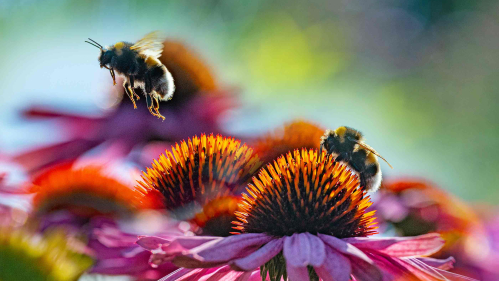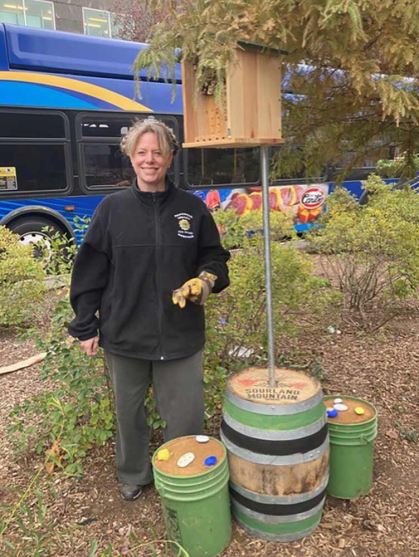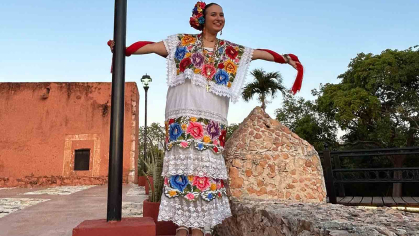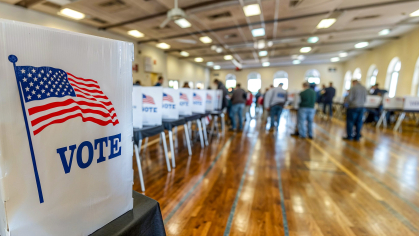Coming Soon to the Urban Landscape: Bunkers and Hotels for Bees

Rutgers scientists conduct experiment using novel structures to aid the proliferation of wild, native bees
Rutgers ecologist Kimberly Russell is the lead researcher on an unusual project that, if successful, will soon allow her to share the idea throughout New Jersey and beyond: the installation of “bee bunkers” and “bee hotels” in spots around New York City to provide nourishment and shelter for at-risk native bee populations.
Russell is an associate professor and the undergraduate program director in the Department of Ecology, Evolution and Natural Resources in the Rutgers School of Environmental and Biological Sciences. A community ecologist, she focuses on conserving the biodiversity of arthropods – invertebrates belonging to the phylum Arthropoda, a group that includes bees, spiders and crustaceans.
She discussed the purpose and importance of the Pollinator Port Project, which is sponsored by the Ittleson Foundation, and is a collaboration between the New York City Department of Transportation, the Horticultural Society of New York and Rutgers University.
Where did the concept of bee bunkers and bee hotels come from? Do they work?
The structures we are calling bee bunkers are the truly innovative part of the project. A former student of mine, Nina Fedoryka, a George H. Cook Scholar, coined the phrase. I think it’s brilliant.
Most people don’t realize that the majority of native bees nest in the ground — nearly three-quarters of the species. Ground-nesting bees are hardest hit in urban areas where bare ground is scarce.
We designed a habitat that, based on what is known about nesting preferences, would appeal to the widest diversity of bees. Bee bunkers provide protected soil into which female bees build their nests and lay their eggs. We submerge the bunkers into the soil of an extra-large planter, so that flowering plants that provide food for the bees could surround and protect it.

Honestly, we don’t know how well the bunkers will work, as there is very little research on it, or even trials similar to ours. We only found one study that tracked the success of human-made soil habitats in an urban setting – in a park in a small city in France. But they had success, so we found that encouraging.
Bee hotels, which look like birdhouses, have been around for quite a while. They will attract a decent proportion of the rest of the bee population that nests in stems and cavities.
Why are native bee populations at risk, and why should that concern the public?
The majority of the plants we enjoy in our gardens and open spaces, as well as many of the plants we depend on for food, require pollination.
Bees are the most abundant and widespread pollinators in the world. We have become unnecessarily dependent on the non-native European honeybee, especially in terms of agriculture.
We have our own native bees that can do the same work if we support them, but they face many threats. Many species are declining in abundance. Caring for bees allows us to care for the plants we need and love.
Doesn’t corralling bees into confined spaces increase the chance of someone being stung?
There are two types of bees in the U.S. that regularly sting humans — the European honeybee and, to a lesser extent, bumblebees. Both live in colonies and sting to protect their extended families. Neither would be interested in bee bunkers or hotels, as they have distinct nesting preferences that require a very different set of characteristics.
No one can fully guarantee that another type of bee won’t sting – all females have stingers, so technically they are capable. But these are very rare events. I have been studying native bees for 20 years and have never been stung by one of my subjects.
Why do you study arthropods? How does your research tie into this project?
As a graduate student, I realized that we know far less about arthropods than we do about vertebrates, despite the fact that we are significantly more reliant on them for survival. I made it my mission to devote my career to understanding the needs of these creatures.
After working with spiders for a number of years, I got involved with a project surveying bee populations at the U.S. Geological Survey’s Patuxent Wildlife Research Center in Maryland. I was always curious about the relationship between bees and plants, so this was my way into considering how those relationships affect extinction risk.
From there, I have been focused on building resilience in wild bee populations by studying ways to develop habitat for them in human-dominated landscapes. This project takes this to an even more urban extreme by trying to supplement and even create habitat in cities for these bees.
As a scientist, what do you hope to learn from this project?
I want to know if we can entice enough native bees to use our bee bunkers to make a real impact.
Little is known about the preferences of ground nesting bees, so this study will provide a real test of what we think we know. I also want to learn how bees navigate around the city — how do they travel from green space to green space? How do they navigate around traffic and buildings? Are they using the street trees as protected flight paths?
One project my lab is working on involves marking bees using safe, biodegradable, colored spots to gain information about their population size and movement. Understanding that movement will help us better place our habitats to provide steppingstones between bigger green spaces.
Are there plans to extend this project to New Jersey and elsewhere?
Yes. Once we see some success with our pilot designs, the idea is to provide the protocols to partners in other cities in New York, New Jersey and elsewhere.
These Pollinator Ports will do the most good in the most naturally impoverished areas for bees, so the focus will be on large cities like Newark and Philadelphia.
But we also want to emphasize that community groups and schools can do this on their own – it is a great way to give the bees a helping hand while educating the public about their importance. This also will help people get in touch with nature, an important component to the mission of the Horticultural Society of New York.


